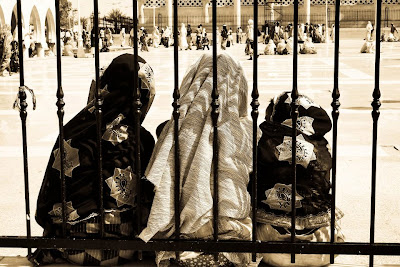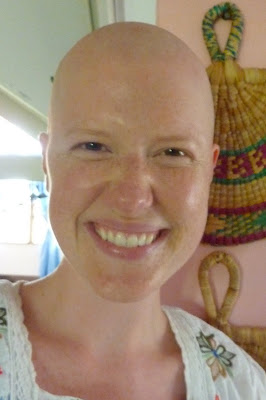Ma angiy Touba: I’m in Touba!
Touba is a town unlike any other that I have experienced here in Senegal. Touba is considered to be a holy city because it is the chosen residence and the sight of the interment of one of Senegal’s historical religious leaders, Cheikh Ahmadou Bamba Mbacké, alias Serigne Touba, who fathered the Muslim Mouride brotherhood. An icon in Senegal, he is revered by most as a leader who aimed to bring the Senegalese people back to the foundations of Islam during the French colonial period of the late 19th and early 20th centuries.
Central to the city is the Grand Mosque—finished in 1963 and fashioned in a heliocentric pattern —which has promoted the movement of waves of settlers arriving from all regions of Senegal to inhabit this unique locale. The city is an agglomeration of several villages, which has become the second most populated region in Senegal, following Dakar; however, due to the poor infrastructure (sand-filled streets and salty water drinking water for example) and the use of horse and donkey carts along side modern transport I found myself thinking that I was in some lost world squeezed into the crevice of two eras.
The Magal is a pilgrimage celebrating the life and doctrine of Serigne Touba, who established Touba for his religious mission: salvation through work to avoid doing what is wrong and to amplify what is right. 2012 marked the 117th year that pilgrims and curious onlookers, like yours truly, have made the journey to Touba.
According to official estimations, approximately three million people traveled to Touba for the day of Magal, the 12th of January, where faithful Mourides recited designated prayers for the memory of Cheikh Ahmadou Bamba between 10 am and 11 am; but the festivities of feasting and purchasing and dancing began long before and would continue long after the religious date of importance. As is characteristic of every Muslim event in Senegal, the religious and the high-spirited gatherings inseparably coincide.
Never have I witnessed such a significant flux of people at one time. I was blessed to leave Dakar with a group of young people who had already experienced the Magal and could aptly navigate the complicated streets upon arrival.
Honestly I do not know what I would have done without them.
We took three horse carts and walked several kilometers in order to locate our hosts’ home. I even fell off one of the horse carts, right into a puddle of mud; but thankfully, I caught myself like a cat and landed flat on my feet! Food was not scarce and the abundance was almost frightening. I tried to refuse some of the food to no avail. In spite of strong protests against the savage quantity of food they wanted me to consume, I succeeded only in acquiescing to their demands, attempting at least to walk off those blasted calories in the sandy streets, inhaling the murky, dusty, polluted air. Senegalese hospitality is truly an all-inclusive phenomenon. On the day of Magal, I changed homes with the help of a deft guide and spent the remaining half with another lovely family who fed me and lodged me just as beautifully as the first. I never worry what I will eat or where I will sleep here in Senegal: there is always some spare rice and a spare mat to share.
Tip #10 for Surviving in Senegal: When walking on the streets of Touba, there are two things for which you must listen, the sound of a referee whistle and the sound of a car horn. I saw as many horse and donkey carts as I did cars, buses and vans. All the cart drivers had a hand-held whistle with which they alerted pedestrians of their impending presence. Being pressed in the middle of the modern and the traditional world presents a host of rare occurrences for which one must be prepared.
Central to the city is the Grand Mosque—finished in 1963 and fashioned in a heliocentric pattern —which has promoted the movement of waves of settlers arriving from all regions of Senegal to inhabit this unique locale. The city is an agglomeration of several villages, which has become the second most populated region in Senegal, following Dakar; however, due to the poor infrastructure (sand-filled streets and salty water drinking water for example) and the use of horse and donkey carts along side modern transport I found myself thinking that I was in some lost world squeezed into the crevice of two eras.
The Magal is a pilgrimage celebrating the life and doctrine of Serigne Touba, who established Touba for his religious mission: salvation through work to avoid doing what is wrong and to amplify what is right. 2012 marked the 117th year that pilgrims and curious onlookers, like yours truly, have made the journey to Touba.
According to official estimations, approximately three million people traveled to Touba for the day of Magal, the 12th of January, where faithful Mourides recited designated prayers for the memory of Cheikh Ahmadou Bamba between 10 am and 11 am; but the festivities of feasting and purchasing and dancing began long before and would continue long after the religious date of importance. As is characteristic of every Muslim event in Senegal, the religious and the high-spirited gatherings inseparably coincide.
Never have I witnessed such a significant flux of people at one time. I was blessed to leave Dakar with a group of young people who had already experienced the Magal and could aptly navigate the complicated streets upon arrival.
Honestly I do not know what I would have done without them.
We took three horse carts and walked several kilometers in order to locate our hosts’ home. I even fell off one of the horse carts, right into a puddle of mud; but thankfully, I caught myself like a cat and landed flat on my feet! Food was not scarce and the abundance was almost frightening. I tried to refuse some of the food to no avail. In spite of strong protests against the savage quantity of food they wanted me to consume, I succeeded only in acquiescing to their demands, attempting at least to walk off those blasted calories in the sandy streets, inhaling the murky, dusty, polluted air. Senegalese hospitality is truly an all-inclusive phenomenon. On the day of Magal, I changed homes with the help of a deft guide and spent the remaining half with another lovely family who fed me and lodged me just as beautifully as the first. I never worry what I will eat or where I will sleep here in Senegal: there is always some spare rice and a spare mat to share.
Tip #10 for Surviving in Senegal: When walking on the streets of Touba, there are two things for which you must listen, the sound of a referee whistle and the sound of a car horn. I saw as many horse and donkey carts as I did cars, buses and vans. All the cart drivers had a hand-held whistle with which they alerted pedestrians of their impending presence. Being pressed in the middle of the modern and the traditional world presents a host of rare occurrences for which one must be prepared.











Comments